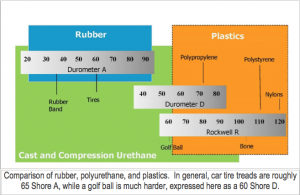
The word DUROMETER comes from DURUS meaning hard and METER loosely meaning measuring instrument. In practical use today, durometer can be used to describe the instrument used to measure hardness, as well as the material’s hardness. Durometer is measured by the depth of an indentation into a test specimen under a standardized force. Softer material will allow a deeper indentation.
 Hardness testers, or durometer gauges, were originally developed to measure metal. As rubber materials came into vogue in the early 1900s, the original gauges were not accurate for measuring the softer, elastomeric materials. Based on need to control quality of these new materials, in 1915, Albert Shore defined what is now known as the Shore A scale and designed the first quadrant type durometer gauge. As more materials, outside of the original hardness range, were developed to feed industry and manufacturing, additional scales were added and named after Shore. Common scales used today for both rubber and cast urethane are Shore A and Shore D.
Hardness testers, or durometer gauges, were originally developed to measure metal. As rubber materials came into vogue in the early 1900s, the original gauges were not accurate for measuring the softer, elastomeric materials. Based on need to control quality of these new materials, in 1915, Albert Shore defined what is now known as the Shore A scale and designed the first quadrant type durometer gauge. As more materials, outside of the original hardness range, were developed to feed industry and manufacturing, additional scales were added and named after Shore. Common scales used today for both rubber and cast urethane are Shore A and Shore D.
ASTM D2240-05 Standard Test Method for Rubber Property – Durometer Hardness, written by ASTM International, is generally accepted in the molding industry. It defines the specimen, controls how the test is performed, and discusses repeatability. For the scientist in all of us, we want durometer measurements to be exact every time, and in reality they are not. Acceptable tolerance on durometer is plus or minus 5 points. In the case of a 50 Shore A nominal value, the lower acceptable limit is 45 Shore A, while the upper is 55 Shore A. Be wary of some of the pitfalls of the process/method, including variance from operator to operator, an unusually cold or warm specimen, and uncalibrated gauge, or too thin of a specimen. Measurements under 20 Shore A and over 90 Shore D are agreed to be unreliable.
The next time you think of gummy bears, I bet you’ll wonder what durometer they are.



